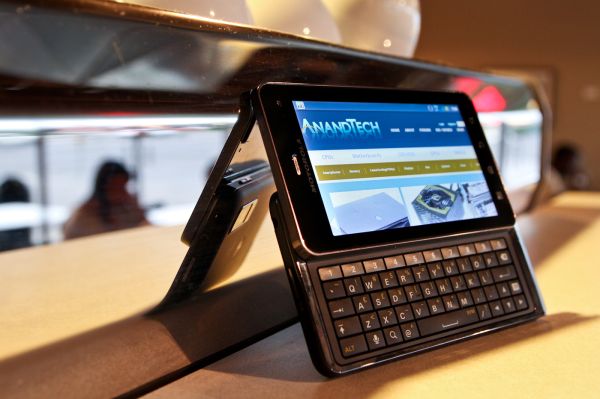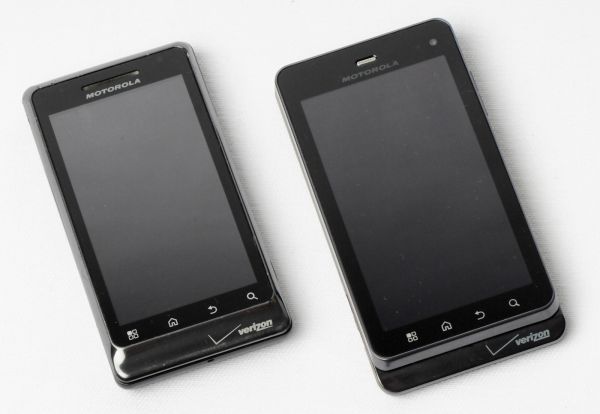Motorola Droid 3 Review - Third Time's a Charm
by Brian Klug on July 30, 2011 12:01 AM ESTIf ever a product has summed up the progression of the Android ecosystem, it’s the Motorola Droid. The first Droid catapulted Android into the mainstream with its first 2.x release, and since then the Droid itself has seen a yearly update cadence that honestly has shown no sign of stopping. The updates thus far track the trends that we’ve seen affect the Android ecosystem as a whole - newer and better versions of Android alongside ever increasing SoC performance, display improvements, camera improvements, and refined hardware design.
I think that pretty much sums up what kind of update the Motorola Droid 3 (henceforth just Droid 3) is. It’s an iterative product launch, for sure, but that belies just how good the improvements all around really are. I noted a few of them already - the Droid 3 includes a dual core OMAP 4430 SoC, larger 4” qHD display, more internal storage, better camera, front facing camera, and most notably a much improved 5 row QWERTY keyboard.
Of course the huge question mark is what has improved connectivity-wise on the Droid 3. There’s no 4G LTE baseband, however, instead of repeating the Droid 2 and Droid 2 Global duopoly, Motorola just went ahead and made the Droid 3 global from the start. That’s right, it’s a dual-mode phone. It’s no consolation if you’re still waiting for an LTE enabled device with a physical keyboard (for that, you’ll have to wait for Samsung to release its rumored next device), but in my mind right now you can either have multi-mode global (CDMA2000 and GSM/UMTS) compatibility or multi-mode (CDMA2000 and LTE) with 4G connectivity. As of yet there’s no having it both ways.
We’ll talk more about all of that in due time, but for now let’s just go over the Droid 3’s outward physical appearance and hardware.
First off, the Droid 3 is notably larger than its predecessor. It’s 3 mm wider, 7 mm taller, but almost 1 mm thinner. Those changes in outline are both to accommodate the 4” screen (as opposed to 3.7”) and likewise the additional keyboard row. Mass is up as well, from 169 to 184 grams. I won’t bore you with all the specifications that have changed, you can just check out the table below.
| Physical Comparison | ||||||
| HTC Thunderbolt | Motorola Droid 2 | Motorola Droid X2 | Motorola Droid 3 | |||
| Height | 122 mm (4.8") | 116.3 mm (4.6") | 126.5 mm (4.98") | 123.3 mm (4.85") | ||
| Width | 67 mm (2.63") | 60.5 mm (2.4") | 65.5 mm (2.58") | 64.1 mm (2.52") | ||
| Depth | 13.2 mm (0.52") | 13.7 mm (0.54") | 9.9 - 14.4 mm (0.39"-0.57") | 12.9 mm (0.51") | ||
| Weight | 183.3 g (6.46 oz) | 169 g (5.9 oz) | 148.8 g (5.25 oz) | 184 g (6.49 oz) | ||
| CPU | 1 GHz MSM8655 45nm Snapdragon | 1 GHz Cortex-A8 OMAP 3620 | 1 GHz Dual Core Cortex-A9 Tegra 2 AP20H | 1 GHz Dual Core Cortex-A9 OMAP 4430 | ||
| GPU | Adreno 205 | PowerVR SGX 530 | ULP GeForce | PowerVR SGX 540 | ||
| RAM | 768 MB LPDDR2 | 512 MB LPDDR2 | 512 MB LPDDR2 | 512 MB LPDDR2 | ||
| NAND | 4 GB NAND with 32 GB microSD Class 4 preinstalled | 8 GB integrated, preinstalled 8 GB microSD | 8 GB NAND, 8 GB microSD class 4 preinstalled | 16 GB NAND, up to 32 GB microSD | ||
| Camera | 8 MP with autofocus and dual LED flash, 720p30 video recording, 1.3 MP front facing | 5 MP with dual LED flash and autofocus | 8 MP with AF/LED Flash, 720p30 video recording | 8 MP with AF/LED Flash, 1080p30 video recording, VGA (0.3MP) front facing | ||
| Screen | 4.3” 800 x 480 LCD-TFT | 3.7" FWVGA 854 x 480 IPS-LCD | 4.3" 960 x 540 RGBW LCD | 4.0" 960 x 540 RGBW LCD | ||
| Battery | Removable 5.18 Whr | Removable 5.2 Whr | Removable 5.65 Whr | Removable 5.65 Whr | ||
Subjectively however, I was shocked at just how thin the Droid 3 feels in the hand in spite of the slide-out keyboard. It seems like generally there’s a certain amount of unacceptable overhead that always comes alongside including an actual keyboard, yet the Droid 3 manages to do it without making it painfully obvious that everything was designed around it instead of with it.
The other major difference is how much different the Droid 3 feels compared to the Droid 2 - entirely as a result of the device using squared edges instead of the rounded chamfers that ringed the Droid 2. There’s been a recent slow march away from rounded industrial design to one dominated by rigid 90 degree angles, and the Droid 3 follows that trend with this move.












84 Comments
View All Comments
RoninX - Sunday, July 31, 2011 - link
I'm guessing that people who prefer a physical keyboard (like myself) would rather manually correct spelling errors than deal with <a href="http://damnyouautocorrect.com/">overly aggressive autocorrect algorithms</a>.I currently have a Droid 2 on a one-year contract that's eligible for an upgrade, and I'm strongly learning toward getting a Droid 3, due largely to the excellent keyboard.
I'll have to see the Pentile screen in-person before making a decision. I find it interesting that some people find the Pentile effect imperceptible, while others find it unbearable.
I'm also curious about the Samsung <a href="http://www.bgr.com/2011/07/29/atts-sleek-samsung-s... which looks like a dual-core Exynos slider. The keyboard doesn't look nearly as good as the Droid 3's, but the 3000+ score on Quadrant (similar to the SGS2) is intriguing...
RoninX - Sunday, July 31, 2011 - link
That should read, the Samsung http://www.bgr.com/2011/07/29/atts-sleek-samsung-s...">SCH-i927 dual-core Exynos slider.hackbod - Monday, August 1, 2011 - link
Auto-correcting input from a hard keyboard is actually very different than from a soft keyboard. A soft keyboard's auto correction is deeply tied to the key layout, and tables built to map specific tap positions on the keyboard to the possible letters that may be intended.The Android IME architecture *does* allow the IME to perform the same kinds of text processing operations on physical keyboard input as it does on touch input. However, in practice, a soft keyboard IME is designed around processing touch input, and you probably wouldn't want it to do the same processing of hard key input because the result would be poor.
jvchapman - Saturday, July 30, 2011 - link
No 4G = Useless.bjacobson - Saturday, July 30, 2011 - link
looks like the display is still sunken down under the gorilla glass like on the Droid1 and Droid2? The more I use others' phones (Samsung Galaxy, Iphone, etc) the more it bugs me on mine...significantly increases glare.bjacobson - Saturday, July 30, 2011 - link
The dragging down notifications bar animation, on all the OMAP based phones I played with, runs at 20-30 FPS best case.The Samsung Galaxy animation for it is much smoother for whatever reason.
This is the biggest beef I have with android phones; I play with my friend's Iphone 3gs and it's still smoother than the latest android hardware...
Mumrik - Saturday, July 30, 2011 - link
I really don't get why we have to have those sucky touch buttons under the screen when they could be proper physical buttons.Myrandex - Monday, August 1, 2011 - link
I agree. I miss call start and end buttons personally.Jason Cook
anandtech pirate - Saturday, July 30, 2011 - link
only 512mb of ram? I'm sure throwing in another 512mb wouldn't have added much to the cost. and I bet the performance boost would have been worth it.also..... whatever happened to the evo3D review?.... just wondering like a lot of other people
tipoo - Saturday, July 30, 2011 - link
Does anything indicate 512MB currently bottlenecks Android or its apps? We just moved away from 256MB not so long ago, after all.